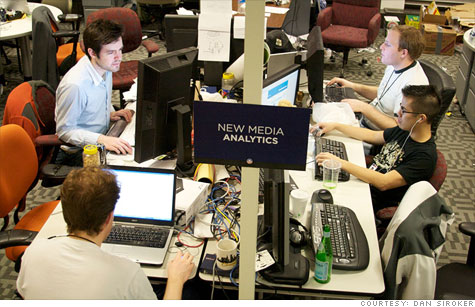Search News

Dan Siroker (upper right corner) helped build the Obama campaign's analytics team, shown here in 2008.
The Obama 2008 campaign's pioneering technology use gave rise to a batch of Silicon Valley startups that are commercializing tools created for the campaign. This article is the first in a series, "America's Choice 2012: The Data Edge," covering those startups and the role they're playing in the 2012 presidential election.
NEW YORK (CNNMoney) -- In late 2007, Dan Siroker -- one of the masterminds behind Google's Chrome browser -- heard then-Senator Barack Obama speak at the Googleplex. That talk prompted Siroker to leave behind his job at Google (GOOG, Fortune 500) and join Obama's campaign as its director of analytics.
"He talked about all the great things he wanted -- taking what we were doing at Google, with evidence and science and feedback, and bringing that to the government," Siroker recalls.
Siroker took Obama's vision literally. Using the campaign as his lab, he began experimenting with how technology could give a candidate an edge. The former Googler introduced the idea of "A/B" testing to Obama's staff, using live Web trials to find out how different website colors, messages, and pictures affected donations and volunteer sign-ups.
"He built a team of analytic experts who had these giant monitors," says Sam Graham-Felsen, Obama's former chief blogger. "They were turned sideways and had all these numbers that people like me had no idea what they were doing, but what they were doing was testing every possible combination or iteration."
Those subtle tweaks raised the site's sign-up rate and ultimately added millions to Obama's fundraising haul, Graham-Felsen estimates.
Siroker was a leader in the Obama campaign's pioneering use of data-crunching. Now, he's at the forefront of another trend: Ex-Obama staffers who have turned their technology creations for the campaign into Silicon Valley startups.
Edward Saatchi is another volunteer-turned-entrepreneur. The internal social networking and progress-tracking tools he built for Obama's election effort have turned into National Field, a startup whose software boosts communication between field offices and their headquarters. Its clients include Northwestern University and the Sierra Club.
Saatchi recalls the freewheeling, try-anything approach the campaign's organizers had to adopting new technology tools.
"When there was a good idea, when there was a good piece of technology, people were really willing to embrace it," he says. "Afterwards, there were a lot of people who though politics was a really exciting place for technology."
Siroker launched Optimizely in early 2010, backed by a $1.2 million funding round from many of Silicon Valley's most prominent angel investors. (Ron Conway, Chris Sacca and Ashton Kutcher are among the backers.) The San-Francisco-based company now has a staff of 16.
"Optimizely is the product I wish we had in 2008 to make it really easy for anybody to do A/B testing," he says. "It doesn't require a developer, it doesn't require an engineer."
Sam Altman, a tech investor who holds a small stake in Optimizely, says the election was a great "proof point" for emerging new technology.
"It's such an intense period," he says of the campaign's relentless pace. "They had done this really impressive thing for Obama, and it had worked in a big way. They were really good at articulating why people were going to need this."
Siroker's customer list now includes major corporations like Starbucks (SBUX, Fortune 500) to eBay (EBAY, Fortune 500), along with those closer to its roots, like social activism site Change.org.
Customer IGN Entertainment calls the service a gamechanger.
When IGN launched a YouTube channel, it used Optimizely to test where to place a "subscribe" feature. Trying various options, the company saw a 65,000% increase in user engagement when it hit on a winning placement.
"The smallest change can make an incredible difference," says IGN business intelligence analyst Lizzie Allen.
Meme master Ben Huh, CEO of the Seattle-based Cheezburger Inc., is another fan. His blog network has been using the service for six months.
"We have a very data-centric perspective at how we look at our user behavior," he says. "You can theorize about what feature will work and how people will use it, but it's not until you put it into reality that it matters."
The Obama 2012 campaign is also a returning customer -- and this time, it's paying for the service.
Siroker says he doesn't know exactly what projects the campaign is using his software for, but he expects both candidates to up their tech game this time around.
"There's a huge opportunity to take things like Facebook data or offline donation data, put that together into one cohesive system, and then run experiments and optimize across that," he says. "I think this election is going to be a lot more about personalization." ![]()